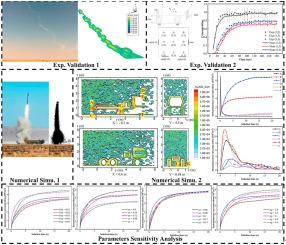基于几何拓扑和壁面约束效应的导弹排气烟雾粒子随机游走弥散模型
IF 4.3
2区 材料科学
Q2 ENGINEERING, CHEMICAL
引用次数: 0
摘要
导弹点火过程中产生的排烟颗粒的扩散受到发射平台几何约束的强烈影响,导致发射区域内烟雾持续积聚,这对导弹的可视性控制和目标探测提出了重大挑战。然而,现有的随机漫步模型(RWM)通常依赖于简化的假设,如自由空间域或规则的边界几何,限制了它们对复杂的墙壁约束场景的适用性。为了填补这一空白,开发了几何拓扑和壁约束随机游走模型(GTWC-RWM)来模拟复杂发射场地环境中的粒子传输。该模型结合了墙壁效应,包括反射、滑动和吸附,通过射线-三角形相交方法进行碰撞检测。碰撞响应参数表示为入射角的二阶多项式,并使用实验数据进行校准,以保证物理一致性。对参考数据和几何障碍场景的验证证实了模型的预测能力,产生的最大相对误差小于26.16%。模拟结果表明,壁面约束效应显著阻碍了色散,阻塞区和非阻塞区之间的浓度梯度高达58.79%。灵敏度分析量化了关键参数对近壁浓度分布的影响。本文章由计算机程序翻译,如有差异,请以英文原文为准。

Random walk dispersion model for missile exhaust smoke particles based on geometric topology and wall constraint effects
The dispersion of exhaust smoke particles generated during missile ignition is strongly affected by geometric confinement from launch platforms, leading to persistent smoke accumulation in the launch area, which poses significant challenges for visibility control and target detection. However, existing Random Walk Model (RWM) typically rely on simplified assumptions such as free-space domains or regular boundary geometries, limiting their applicability to complex wall-constrained scenarios. To fill this gap, a Geometric Topology and Wall-Constrained Random Walk Model (GTWC-RWM) is developed to simulate particle transport in complex launch-site environments. The model incorporates wall effects—including reflection, slip, and adsorption—through ray–triangle intersection methods for collision detection. Collision response parameters are expressed as second-order polynomials of incidence angle and calibrated using experimental data to ensure physical consistency. Validation against reference data and geometric obstacle scenarios confirms the model's predictive capability, yielding a maximum relative error of less than 26.16 %. Simulations reveal that wall-constrained effects significantly impede dispersion, with concentration gradients reaching up to 58.79 % between obstructed and unobstructed regions. A sensitivity analysis quantifies the influence of key parameters on near-wall concentration distributions.
求助全文
通过发布文献求助,成功后即可免费获取论文全文。
去求助
来源期刊

Particuology
工程技术-材料科学:综合
CiteScore
6.70
自引率
2.90%
发文量
1730
审稿时长
32 days
期刊介绍:
The word ‘particuology’ was coined to parallel the discipline for the science and technology of particles.
Particuology is an interdisciplinary journal that publishes frontier research articles and critical reviews on the discovery, formulation and engineering of particulate materials, processes and systems. It especially welcomes contributions utilising advanced theoretical, modelling and measurement methods to enable the discovery and creation of new particulate materials, and the manufacturing of functional particulate-based products, such as sensors.
Papers are handled by Thematic Editors who oversee contributions from specific subject fields. These fields are classified into: Particle Synthesis and Modification; Particle Characterization and Measurement; Granular Systems and Bulk Solids Technology; Fluidization and Particle-Fluid Systems; Aerosols; and Applications of Particle Technology.
Key topics concerning the creation and processing of particulates include:
-Modelling and simulation of particle formation, collective behaviour of particles and systems for particle production over a broad spectrum of length scales
-Mining of experimental data for particle synthesis and surface properties to facilitate the creation of new materials and processes
-Particle design and preparation including controlled response and sensing functionalities in formation, delivery systems and biological systems, etc.
-Experimental and computational methods for visualization and analysis of particulate system.
These topics are broadly relevant to the production of materials, pharmaceuticals and food, and to the conversion of energy resources to fuels and protection of the environment.
 求助内容:
求助内容: 应助结果提醒方式:
应助结果提醒方式:


